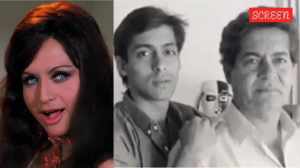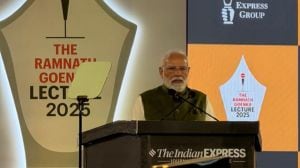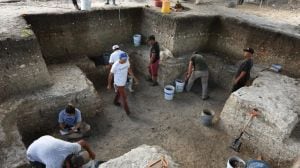A place in search of a NEW IMAGE
The scars of that night are still there. But Bhopal doesnt want to remain that city where that tragedy happened.
The scars of that night are still there. But Bhopal doesnt want to remain that city where that tragedy happened. Its businesses say they missed the first 15 years of Indias economic change. Its young want what the young everywhere want. The city where Raajneeti was shot,where the roads are wide but the traffic is too light,wants to show that a tragedy is not a contagion
Tragedy belongs to a time and a place. Or does it? Is it not carried like a fever in the brain,like a contagion in the blood,like the mad memories of a midnight?
In Bhopal,Ranjit Kumar Dutta stands under the canopy of a flowering palash tree on whose branches droops a peacock,with the cackle of an aviary in the background. He is a few kilometers and a world away from the rusting relic of the insecticide plant of the Union Carbide India Ltd (UCIL),its enormous turbines and pipes gaping into barrenness,its still acrid air,its bottles of acid gathering dust in a corner,its infamous tank E 610 that burst out of its subterranean cavern on December 2,1984,lying bare to curious visitors,its slogan Safety is Everybodys Business staring from a wall in the control room in all irony.
Yet,when 77-year-old Dutta,one of the first employees and the first Indian works manager of the UCIL plant,speaks,he is not referring to a corroding monstrosity that spat a cloud of methyl isocyanate (MIC) over a city,but to a totem of chemical engineering in the Seventies India. The Bengali chemical engineer remembers first coming to Bhopal in 1969,a place that was little more than a village,a jungle,on the orders of Eduardo Munoz,the enthusiastic Argentine who headed the South and East Asia divisions of the Union Carbide Corporation. They were to build a formulation plant for the insecticide Sevin,which Dutta would call the saviour of cotton crop in India. There was no fear that something would go wrong, he says,The design of the MIC plant was better than that in the US.
On that wintry December night,Dutta,who was managing the business operations in the US office,was proved wrong as Bhopalis ran out of their homes with babies crying in their arms,eyes burning,breath shallow. They were given eye drops,recalls Dr NR Bhandari,who was medical superintendent of Hamidia Hospital,and the doctors who had never heard of MIC did not know the antidote for it. That tragedy should never have happened, says Dutta,It was sheer carelessness that led to it. You know,just three more months on March 1985,the plant would have been closed down. That decision had already been made. He resigned from the company and returned to Bhopal,but the man who bought the first five acres for the plant never once went back to see what became of it.
On the other end of the city,in Old Bhopal,JP Nagar is a cluster of small houses arranged on either side of snaking narrow bylanes. It is right across the road from the UCIL plant. There they know what became of it. In the home of Hajra Bi,an illiterate woman who has counted the facts and figures of the gas tragedy,a TV channel is blaring breaking news of Bhopal. She has left her burkha to become an activist. In the lane behind,as a dust storm swirls,Bismillah Bi talks about losing her four-year-old son Sajid Ali to that night. A few doors to her left,Leela is mourning her daughter Rajkumari who died on May 14. She says her girl never quite recovered from the effects of that poison. Leelas son Jagdeesh born three years after the gas tragedy looks like an adolescent. He is too weak to do anything, she says. In JP Nagar,most houses are pucca now,some have televisions,room coolers and mobile phones bought with the little compensation money that came their way. But tap on those seemingly solid walls,and you would see crumbled lives.
Dutta and Leela are the two ends of a spectrum,two ends of a city that carries that miserable night in different ways. The city too was framed by that night. For everyone outside,it was the gas tragedy city, says Nandita Chibber,27,who works as a radio professional. Apart from the human toll and ecological disaster,that image led to the citys economic undoing as well,says Rajendra Kothari,resident director of the PHD Chamber of Commerce and Industry,Bhopal. Those who did not suffer forgot about the gas tragedy,but not many people realised how the citys economy became a casualty, he says. It took us 20 years to move on. We missed the first 15 years of liberalisation.
Kothari returns to the Seventies Bhopal when its location,in the heart of India,was considered a logistical advantage by companies. There were the Bharat Heavy Electricals Ltd (BHEL),the UCIL being set up with American investment,the HEG coming up with French assistance and JK Batteries with German help. Jacob Mani,chief strategic officer of HEG,Asias largest manufacturer and exporter of graphite electrodes,at Mandideep just outside Bhopal,says the story was different when HEG came up in 1976. Madhya Pradesh was a power surplus state with the promise of it becoming a logistics hub. But after 1984,the citys image affected businesses from coming in, says Kothari. While investment poured into Bangalore and Hyderabad,Bhopal lagged behind.
Adds Mani: The city survived on compensation money when it should have been thriving on industrial investment. Bhopal is what Bangalore was 20 years ago.
Mani refuses to blame the tragedy; instead he points to the perpetration of an image and the lack of political will to give the state capital a positive framework. Mumbai did not stop at 26/11. Gujarat is growing in spite of the riots. There is no political willpower to make and sell Bhopal as an investment destination, he says.
Bhopal is a city that is in search of a new image. The primary narrative coming out of it has been grief,but we are not a weeping city anymore, says Chibber. Filmmaker Prakash Jha who had made a documentary on the gas tragedy drew out an alternative narrative of Bhopal when he set his movie Raajneeti against the pink arches of Iqbal Maidan and the silver skein of its placid lakes. It is a beautiful place and the perception about it has to change,says Jha,who is going back for his next movie Aarakshan.
It is a tiered city too. The spacious,lakefront New Bhopal is far from the UCIL plant geographically and emotionally. Its roads are wide too wide,in fact,for its trickling traffic and fringed by green that is uncharacteristic in north Indian cities. Among whitewashed,low-roofed government quarters,markets have come up,brands have arrived,a mall is in the works. They havent forgotten that night but they dont remember it either. On the elitist bougainvillea-ed Shamla Hills,families confess to having slept through that night. And there is a part of congested,dusty Old Bhopal looking for closure.
Some kind of justice. A better compensation.
But the citys memories are also tiered. Across Old and New Bhopal,there is a generation for whom December 2 is either grandmothers nightmares or vague childhood memories. Bismillah Bis younger son Wasim wonders why we are still talking about it; a 13-year-old schoolgirl looks forward to a mall like they have in Mumbai; Afaq Ali,21,has to take his mother to the Bhopal Memorial Hospital and Research Centre for another surgery but I dont think about the gas tragedy. I want to get a government job; Jagdeesh says,I want the government to help me find a future.
They dont want to carry that tragedy like a fever in the brain,like a contagion in the blood,like the mad memories of a midnight. They want to confine it to a place and a time. It is not easy. But they want to.



- 01
- 02
- 03
- 04
- 05




























